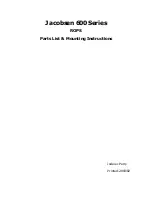
4.3 Measuring Current
61
1
2
3
4
5
6
7
8
9
10
M
easurement
P
ro
cedure
For Current Measurement
• AC and AC+DC modes
If fluctuations cause measured values to be hard to read, press
SHIFT
→
(
SAMPLE
) to select the SLOW display update
rate.
• When the display update rate is
SLOW
and the measurement
range changes automatically (by AUTO ranging) as a result of
a change in measured current, correct measurement is tempo-
rarily inhibited (because the display update rate is faster than
the measurement response time affected by the range
change). Erroneous MAX and MIN values may also be dis-
played.
If the range can be expected to change because of a change in
measured current, manually select the H range.
• When measuring a fast-rising current such as starting current,
set the display update rate to FAST. Also, by pressing the
button so that MAX is displayed, the maximum value
can be read.
• In the L range, the maximum display is 2500 dgt.
•
O.L.
indicates over-range.
• When or is displayed on the bar graph, it indicates that an
over-range negative or positive condition occurred during peak
current measurement.
For Frequency Measurement
• When the amplitude of the current being measured is near the
bottom of the L range (5% or less of the full range), frequency
measurement may be incorrect. The bar graph indicates the
current measurement value. In this case, "
" or
O.L.
is
displayed, or the displayed value becomes unstable.
• If the measured frequency is 1 Hz or less, the bar graph indi-
cates "
". If the measured frequency is 1 kHz or more,
O.L.
is displayed.
• Depending on the measured frequency, some time may be
necessary for the measurement to stabilize.
• When measuring 10 Hz or less, depending on the amplitude of
the current being measured, the frequency may not be dis-
played. In this case, set the display update rate to SLOW in the
AC mode before switching to the Hz mode.
• Frequency measurement is performed by zero-crossing detec-
tion. However, because non-sinusoidal waveforms such as
inverter outputs are low-pass filtered, the frequency may not
be measurable in some cases (if the carrier frequency is as low
as several kHz, the carrier component may not be sufficiently
suppressed by the filter, so zero crossings are improperly
detected and the indicated frequency is too high).
• If the waveform includes DC bias, zero crossings may not be
detected and the indicated frequency may be too high or
unstable.
Содержание 3290-10
Страница 1: ...CLAMP ON AC DC HiTESTER INSTRUCTION MANUAL 3290 10...
Страница 2: ......
Страница 6: ...iv Contents...
Страница 14: ...8 Usage Notes...
Страница 42: ...36 2 5 Turning Power On and Off...
Страница 54: ...48 3 6 Measuring Duty by Timer...
Страница 149: ...4 5 6 7 8 9 10 11...
Страница 150: ......
















































